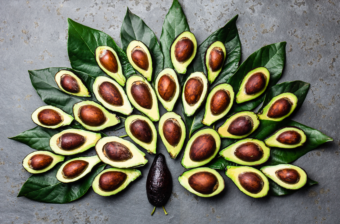Secrets of the Avocado
 Inside that textured green skin, it’s ripe with mystery. It’s an “evolutionary anachronism.” It’s not a vegetable, and not exactly your typical fruit. It’s an acquired taste that most Americans still resist. Meet the avocado.
Inside that textured green skin, it’s ripe with mystery. It’s an “evolutionary anachronism.” It’s not a vegetable, and not exactly your typical fruit. It’s an acquired taste that most Americans still resist. Meet the avocado.
HAVING A BALL
The avocado came from South America, so it’s not too surprising that the Nahuatl language of the ancient Aztecs gave us its name, derived from ahuacatl. Besides referring to the fruit, the word had another meaning: “testicle,” which also isn’t too surprising, considering the fruit’s shape and texture. Although “guacamole” doesn’t really sound like “avocado,” the two words share a root: Guacamole comes from the Nahuatl ahuacatl-molli, which means “avocado sauce.” (The fact that it also means “testicle sauce” is probably not something we want to dwell on.)
BEEN THERE, DUNG THAT
Biologists suggest that it’s a lucky accident the avocado is still with us, because it evolved to fill a niche in an ecosystem that went extinct eons ago. As with many fruits, the avocado developed as a mutually beneficial trade-off with animals. The tree provides tasty food, but there’s no such thing as a free lunch—the plant’s price for its fruit is mobility for its seeds. How does that work? The seeds of the fruit are typically small enough to pass through the digestive systems of the animals that eat it. The seeds are often bitter, sometimes even toxic enough to cause nausea. So animals rarely chew them more than once, but instead learn to swallow them whole. The seeds exit the digestive system intact, as waste, and end up planted in the animal’s nutrient-rich dung.
There’s no reason to believe that the avocado was an exception to this rule. It’s unlikely that the plant species’ survival was ever meant to depend on humans poking its seed with toothpicks and suspending it in water to get it to sprout. But that begs the question: What animal in South America is big enough to eat a avocado whole and poop out its oversize pit?
ANIMANIACS
The answer, of course, is that there is none. Not anymore, anyway. As with the mango and the dodo fruit, the plant’s animal partner is no longer with us, making it what scientists call an “evolutionary anachronism.” Long ago, South America was ruled by megafauna, giant animals that lived until humans arrived and apparently hunted them to extinction, around 10,000 to 20,000 years ago.
For millions of years South America was an island, not yet connected to North America, allowing for richly diverse evolution of animals such as the glyptodon, an armadillo the size of a Volkswagen Beetle, and the sleek macrauchenia (“long neck”), a 10-foot-long grass eater that looked like a cross between a horse, a camel, a giraffe, and a svelte elephant. Then there were the giant ground sloth, 20 feet long and weighing five tons, and the gomphothere, an oversize elephant-like creature that might have roamed South America as recently as 9,000 years ago. All four are prime candidates for being the avocado’s co-evolutionary pals. But if the fruit hadn’t turned out to be tasty to humans, it may well have gone the way of the glyptodon and the gomphothere.
AVOCADO FACTS
- Good For You. Avocados are full of nutrients and cholesterol-lowering monounsaturated fat. However, the fruit, leaves, pit, and skin have been documented as harmful—and sometimes deadly—to many animals, including cats, dogs, rabbits, birds, horses, goats, cattle, rodents, and fish. But not all parts are poisonous to every animal. While the fruit can kill birds, at least one pet food manufacturer has added avocado pulp and oil to its line of cat and dog foods as a coat conditioner, without any known ill effects.
- What Hass Got Rot? There are dozens of avocado varieties. The most common by far is the Hass avocado, accounting for about 80 percent of all cultivated avocado trees worldwide. And all of them are descended from the cuttings of a single tree owned by Rudolph Hass, a mail carrier who lived in La Habra Heights, California. In 1935, Hass noticed that the tree of unknown lineage produced great fruit year-round, so he patented it and sold its cuttings. (His original tree died of root rot in 2002.)
- Production. Of America’s avocado crop, 90 percent comes from California. Of those, 60 percent come from San Diego County. How many avocados can a typical commercial tree produce each year? About 500, totaling 200 pounds of fruit. But don’t expect to see any advertisements for “tree-ripened avocados.” The avocado is unusual in that it won’t ripen on the tree. Avocados can be kept mature but unripe for weeks or even months by leaving them on the tree or refrigerating them until they arrive at their retail destination. After only a few days at room temperature, they ripen into the semi-squishy state that consumers want.
- Fruits or Vegetables? Based on the fact that avocados grow on trees, you’d assume that the avocado is classified as a fruit. That’s correct. But what kind of fruit? According to the University of California, it isn’t like most tree fruits—apples, pears, or peaches—it’s a “single-seeded berry.”
- Hernando Cortés, Food Critic. Native American populations have been cultivating avocados for thousands of years. When he wasn’t busy looting and destroying cities, conquistador Hernando Cortés took the opportunity to try an avocado in Mexico. He wrote: “In the center of the fruit is a seed like a peeled chestnut. And between this and the rind is the part which is eaten, which is abundant, and is a paste similar to butter and of very good taste.”
- What’s in a Name? In 1960 the British retail chain Marks & Spencer tried introducing avocados to English consumers. Figuring the name was too foreign-sounding, the store marketed the fruit as “alligator pears.” Unfortunately, its customers thought of pears as being something you made into a dessert…the culinary results were disastrous. After numerous complaints about inedible “alligator pear” tarts and pies, Marks & Spencer decided “avocado” wasn’t such a bad name after all.
 This article is reprinted with permission from Uncle John’s 24 Karat Gold Bathroom Reader. The information miners at the Bathroom Readers’ Institute have unearthed a priceless collection of surprising, amazing, headscratching, and hilarious articles. 24-Karat Gold is chock-full of little-known history, random origins, weird news, celebrity secrets, and urban legends.
This article is reprinted with permission from Uncle John’s 24 Karat Gold Bathroom Reader. The information miners at the Bathroom Readers’ Institute have unearthed a priceless collection of surprising, amazing, headscratching, and hilarious articles. 24-Karat Gold is chock-full of little-known history, random origins, weird news, celebrity secrets, and urban legends.
Since 1987, the Bathroom Readers’ Institute has led the movement to stand up for those who sit down and read in the bathroom (and everywhere else for that matter). With more than 15 million books in print, the Uncle John’s Bathroom Reader series is the longest-running, most popular series of its kind in the world.
If you like Today I Found Out, I guarantee you’ll love the Bathroom Reader Institute’s books, so check them out!
| Share the Knowledge! |
|





well this was an adventure from start to finish
(you listed “rabbits” twice, btw)
ahuacatl is more closer in sound to the Spanish word aguacate.
Avocado has been a favourite in my country for ages. It’s an extremely tasty dessert and drink. Just Google ‘Avocado recipe Sri Lanka’ and try it out.